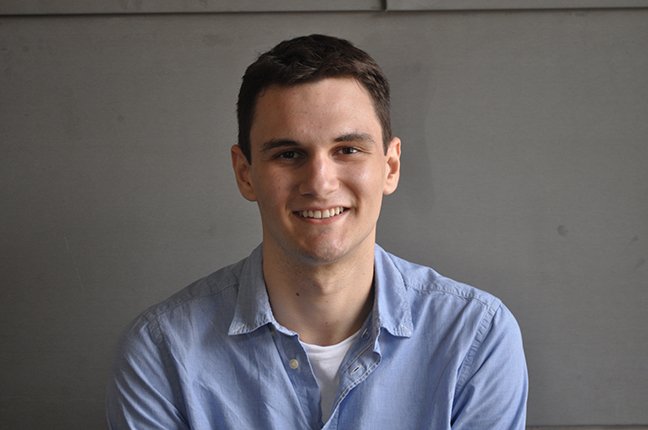Matt Simons receives Amelar and Lodge Fellowship

Matt Simons has received the Richard D. Amelar and Arthur S. Lodge Fellowship for Outstanding Collaborative Research in Materials for 2020-21. This award is given to a student whose research interests encompass the overlapping scope of chemistry and chemical engineering and materials science. Award winners must have demonstrated excellence in their areas of interest and a willingness to collaborate with other students and/or research groups.
Matt is co-advised by Professor Aditya Bhan in Chemical Engineering & Materials Science (CEMS) and Professor Laura Gagliardi in Chemistry, and his research focuses on studying the ability of Metal-Organic Framework (MOF) materials to activate light alkanes by direct oxidative pathways. These pathways offer an opportunity to synthesize functionalized chemicals from light alkanes—small, saturated hydrocarbons found in abundance in cleaner carbon sources such as shale and natural gas—that overcome the expense and inefficiency associated with existing indirect routes. MOFs have been proposed as catalysts due to their modular, crystalline structure that afford the opportunity to synthesize well defined, isolated active sites.
Matt has used both experimental and computational techniques, in addition to collaborations with groups with wide characterization experience, to evaluate the structure and reactivity of these materials. His initial work, with collaborators within the Inorganic Catalyst Design Center (ICDC) at the University of Minnesota and Northwestern University, focused using Density Functional Theory (DFT) to understand the reactivity of mixed metal-oxide clusters supported on the MOF NU-1000 for the oxidation of propane[1]. Structure-activity relationships were obtained that matched well with corresponding experiments, provided deeper understanding of the reactivity of small oxide clusters, and proffered target formulations to further improve the reactivity.
Since then, Matt’s work has focused on studying iron-based MOFs and their reactivity toward light alkanes. In a multi-institution, interdisciplinary effort spearheaded by groups at the University of Minnesota, Matt and coworkers discovered and detailed the reactivity of an iron-based MOF that contains an active site that mimics the structure of species found in enzymatic systems that perform similar chemistry[2]. Matt led the experimental evaluation of the catalyst reactivity and bulk crystallinity, porosity, and stability of the material. This was aided by Professor Karena Chapman’s group at Stony Brook University who confirmed the structure using pair distribution function analysis. Atom-specific spectroscopic techniques—X-ray Absorption spectroscopy in collaboration with Professor Bruce Gates at University of California, Davis, and Simon Bare, Ph.D., at Stanford Synchrotron Radiation Lightsource, and Mössbauer Spectroscopy with Peter Solheid, Ph.D., at the University of Minnesota—helped determine the speciation of iron within the materials. These techniques, in concert with further titration experiments performed by Matt, provided evidence for the identity and quantity of the biomimetic iron site contained within the MOF. In agreement with the reaction kinetics, DFT calculations performed by Jenny Vitillo, Ph.D., a post-doctoral researcher working with Professor Gagliardi and Professor Connie Lu, proposed the reaction mechanism is analogous to that occurring in enzymatic systems.
In addition to continuing collaborations noted above to further explore the reactivity of these materials, Matt aims to work closely with Professor Lu’s group to study the effect of changing metal composition and MOF topology on the reactivity of these materials to generate structure-activity relationships that can guide the rational design of new catalysts.
Matt was born in England and went to Imperial College London, UK for his undergraduate studies, earning a MEng in Chemical Engineering in 2016. His prior research as an undergraduate included modelling Covalent-Organic Framework materials with Prof. Kim Jelfs At Imperial College London, and modelling a Fisher-Tropsch reactor at Shell. He chose to pursue a Ph.D. at the University of Minnesota in 2016 under the supervision of Professor Bhan and Professor Gagliardi, sponsored by the Inorganometallic Catalyst Design Center, an Energy Frontier Research Center funded by the Department of Energy.
The Richard D. Amelar and Arthur S. Lodge Fellowship for Outstanding Collaborative Research in Materials was created by Susanna and Timothy Lodge in honor of their fathers who were accomplished scientists.
[1] Simons, M.C.; Ortuño, M.A.; Bernales, V.; Gaggioli, C.A.; Cramer, C.J.; Bhan, A.; Gagliardi, L. C–H Bond Activation on Bimetallic Two-Atom Co-M Oxide Clusters Deposited on Zr-Based MOF Nodes: Effects of Doping at the Molecular Level. ACS Catal. 2018, 8, 2864−2869. https://doi.org/10.1021/acscatal.8b00012.
[2] Simons, M.C.; Vitillo, J.G.; Babucci, M.; Hoffman, A.S.; Boubnov, A.; Beauvais, M.L.; Chen, Z.; Cramer, C.J.; Chapman, K. W.; Bare, S.R.; Gates, B. C.; Lu, C.C.; Gagliardi, L.; Bhan, A. Structure, Dynamics, and Reactivity for Light Alkane Oxidation of Fe(II) Sites Situated in the Nodes of a Metal-Organic Framework. J. Am. Chem. Soc. 2019, 141 (45), 18142–18151. https://doi.org/10.1021/jacs.9b08686.